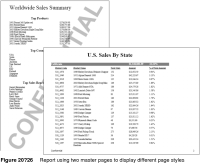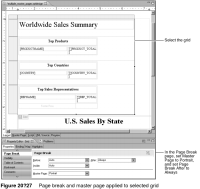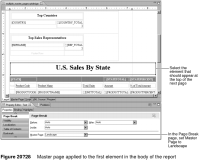Using multiple master pages
You can use multiple master pages in a single report. A report can use different master pages to display, for example, one section of a report in portrait mode and another section in landscape mode. Using multiple master pages, you can also specify different background color, or different header and footer content for different sections of a report. Figure 20‑26 shows a report that uses two master pages. The first page uses a master page that has portrait mode and a watermark. The second page uses a master page that has landscape mode and text in the footer.
To use multiple master pages in a report:

Create the master pages. You can create any number of master pages through the Outline view. Right-click MasterPages and choose Insert Element to add a new master page to the report design.

Specify a page break for each report section that uses a different master page.

Assign a master page to each report section.
For example, to design the report in Figure 20‑26, two master pages, named Portrait and Landscape, are created. The Portrait master page is applied to the first report page, and the Landscape master page to the body of the report, using the following procedure:

Select the report section to appear on the title page, and on Property Editor, choose Page Break. On the Page Break page, set the Master Page property to Portrait. Then, set the Page Break After property to Always. Figure 20‑27 shows a grid selected, and its master page and page break properties set. The grid contains all the elements used to display data on the first page.

Select the first element that appears on the body of the report, which starts on the next page. Set its master page to Landscape, as shown in Figure 20‑28. The Landscape master page is used for the rest of the pages in the report.



